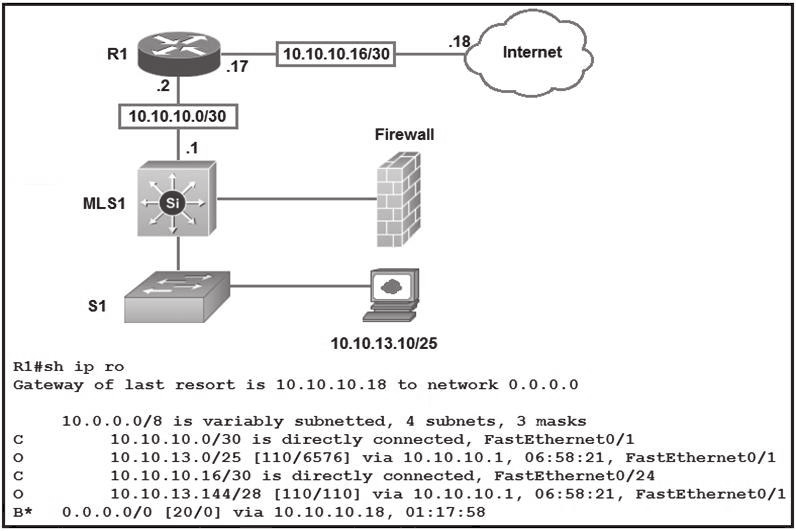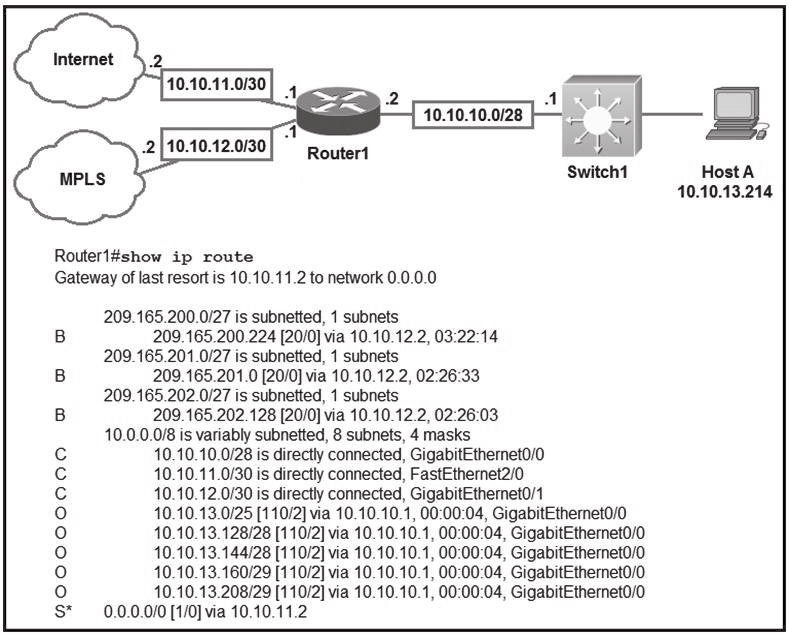Download Cisco Certified Network Associate (200-301 CCNA).200-301.Dump4Pass.2021-03-26.369q.vcex
| Vendor: | Cisco |
| Exam Code: | 200-301 |
| Exam Name: | Cisco Certified Network Associate (200-301 CCNA) |
| Date: | Mar 26, 2021 |
| File Size: | 16 MB |
| Downloads: | 5 |
How to open VCEX files?
Files with VCEX extension can be opened by ProfExam Simulator.
Discount: 20%
Demo Questions
Question 1

Refer to the exhibit. Which type of route does R1 use to reach host 10.10.13.10/32?
- default route
- network route
- host route
- floating static route
Correct answer: B
Explanation:
Dump4Pass Dump4Pass
Question 2

Refer to the exhibit. Which prefix does Router1 use to Host A?
- 10.10.10.0/28
- 10.10.13.0/25
- 10.10.13.144/28
- 10.10.13.208/29
Correct answer: D
Explanation:
Dump4Pass Dump4Pass
Question 3
Drag and drop the descriptions of file-transfer protocols from the left onto the correct protocols on the right.
Correct answer: To work with this question, an Exam Simulator is required.
Question 4
A frame that enters a switch fails the Frame Check Sequence. Which two interface counters are incremented?
(Choose two.)
- input errors
- frame
- giants
- CRC
- runts
Correct answer: AD
Explanation:
Whenever the physical transmission has problems, the receiving device might receive a frame whose bits have changed values. These frames do not pass the error detection logic as implemented in the FCS field in the Whenever the physical transmission has problems, the receiving device might receive a frame whose bits have changed values. These frames do not pass the error detection logic as implemented in the FCS field in the
Question 5
Drag and drop the IPv4 network subnets from the left onto the correct usable host ranges on the right.
Correct answer: To work with this question, an Exam Simulator is required.
Question 6
How do TCP and UDP differ in the way that they establish a connection between two endpoints?
- TCP uses the three-way handshake, and UDP does not guarantee message delivery.
- TCP uses synchronization packets, and UDP uses acknowledgement packets.
- UDP provides reliable message transfer, and TCP is a connectionless protocol.
- UDP uses SYN, SYN ACK, and FIN bits in the frame header while TCP uses SYN, SYN ACK, and ACK bits.
Correct answer: A
Question 7
Which 802.11 frame type is association response?
- management
- protected frame
- action
- control
Correct answer: A
Explanation:
Reference: https://en.wikipedia.org/wiki/802.11_Frame_Types Reference: https://en.wikipedia.org/wiki/802.11_Frame_Types
Question 8
In which way does a spine-and-leaf architecture allow for scalability in a network when additional access ports are required?
- A spine switch and a leaf switch can be added with redundant connections between them.
- A spine switch can be added with at least 40 GB uplinks.
- A leaf switch can be added with connections to every spine switch.
- A leaf switch can be added with a single connection to a core spine switch.
Correct answer: C
Explanation:
Spine-leaf architecture is typically deployed as two layers: spines (such as an aggregation layer), and leaves (such as an access layer). Spine-leaf topologies provide high-bandwidth, low-latency, non-blocking server-to-server connectivity. Leaf (aggregation) switches are what provide devices access to the fabric (the network of spine and leaf switches) and are typically deployed at the top of the rack. Generally, devices connect to the leaf switches. Devices can include servers, Layer 4-7 services (firewalls and load balancers), and WAN or Internet routers. Leaf switches do not connect to other leaf switches. In spine-and-leaf architecture, every leaf should connect to every spine in a full mesh. Spine (aggregation) switches are used to connect to all leaf switches and are typically deployed at the end or middle of the row. Spine switches do not connect to other spine switches. Spine-leaf architecture is typically deployed as two layers:
spines (such as an aggregation layer), and leaves (such as an access layer). Spine-leaf topologies provide high-bandwidth, low-latency, non-blocking server-to-server connectivity. Leaf (aggregation) switches are what provide devices access to the fabric (the network of spine and leaf switches) and are typically deployed at the top of the rack. Generally, devices connect to the leaf switches. Devices can include servers, Layer 4-7 services (firewalls and load balancers), and WAN or Internet routers.
Leaf switches do not connect to other leaf switches. In spine-and-leaf architecture, every leaf should connect to every spine in a full mesh. Spine (aggregation) switches are used to connect to all leaf switches and are typically deployed at the end or middle of the row. Spine switches do not connect to other spine switches.
Question 9
Which statement identifies the functionality of virtual machines?
- The hypervisor communicates on Layer 3 without the need for additional resources.
- Each hypervisor can support a single virtual machine and a single software switch.
- The hypervisor can virtual physical components including CPU, memory, and storage.
- Virtualized servers run most efficiently when they are physically connected to a switch that is separate from the hypervisor.
Correct answer: C
Question 10
Which command automatically generates an IPv6 address from a specified IPv6 prefix and MAC address of an interface?
- ipv6 address dhcp
- ipv6 address 2001:DB8:5:112::/64 eui-64
- ipv6 address autoconfig
- ipv6 address 2001:DB8:5:112::2/64 link-local
Correct answer: C
HOW TO OPEN VCE FILES
Use VCE Exam Simulator to open VCE files

HOW TO OPEN VCEX AND EXAM FILES
Use ProfExam Simulator to open VCEX and EXAM files


ProfExam at a 20% markdown
You have the opportunity to purchase ProfExam at a 20% reduced price
Get Now!



